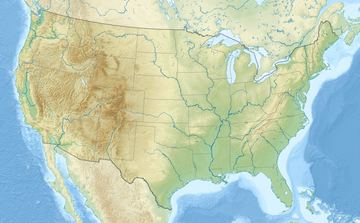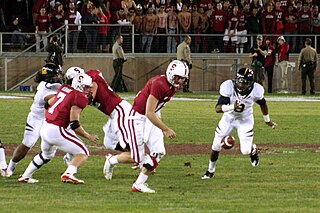
A fumble in gridiron football occurs when a player who has possession and control of the ball loses it before being downed (tackled), scoring, or going out of bounds. By rule, it is any act other than passing, kicking, punting, or successful handing that results in loss of ball possession by a player.

Stephen Wood Van Buren was an American professional football player who was a halfback for the Philadelphia Eagles of the National Football League (NFL) from 1944 to 1951. Regarded as a powerful and punishing runner with excellent speed, through eight NFL seasons he won four league rushing titles, including three straight from 1947 to 1949. At a time when teams played 12 games a year, he was the first NFL player to rush for over ten touchdowns in a season—a feat he accomplished three times—and the first to have multiple 1,000-yard rushing seasons. When he retired, he held the NFL career records for rushing attempts, rushing yards, and rushing touchdowns.

Brian Patrick Dawkins Sr., nicknamed "Weapon X", is an American former professional football player who was a safety for 16 seasons in the National Football League (NFL), primarily with the Philadelphia Eagles. He played college football for the Clemson Tigers and was selected by the Eagles in the second round of the 1996 NFL Draft. In his last three seasons, he played for the Denver Broncos.
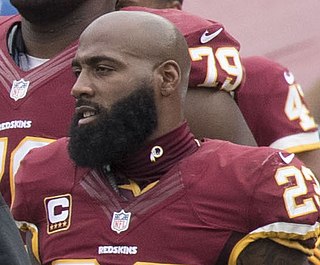
DeAngelo Eugene Hall is an American professional football coach and former player who was a defensive back for 14 seasons in the National Football League (NFL). He played college football for the Virginia Tech Hokies and was selected by the Atlanta Falcons with the eighth overall pick in the 2004 NFL Draft. Hall played half a season for the Oakland Raiders before being traded to the Washington Redskins in 2008, playing for them until retiring following the 2017 season. He was a cornerback for the majority of his career before playing at free safety during his last few seasons.
The 1990 NFL season was the 71st regular season of the National Football League (NFL). To increase revenue, the league, for the first time since 1966, reinstated bye weeks, so that all NFL teams would play their 16-game schedule over a 17-week period. Furthermore, the playoff format was expanded from 10 teams to 12 teams by adding another wild card from each conference, thus adding two more contests to the postseason schedule; this format was modified with realignment in 2002 before the playoffs expanded to 14 teams in 2020.
The 1961 NFL season was the 42nd regular season of the National Football League (NFL). The league expanded to 14 teams with the addition of the Minnesota Vikings, after the team's owners declined to be charter members of the new American Football League. The schedule was also expanded from 12 games per team to 14 games per team where it would stay for 16 years. The Vikings were placed in the Western Conference, and the Dallas Cowboys were switched from the Western Conference to the Eastern. The addition of the Vikings returned the NFL to an even number of teams.
The 1947 NFL season was the 28th regular season of the National Football League. The league expanded the regular season by one game from eleven games per team to twelve, a number that remained constant for fourteen seasons, through 1960.
The 1949 NFL season was the 30th regular season of the National Football League. Prior to the season, Boston Yanks owner Ted Collins asked the league to fold his team due to financial woes, and give him a new one in New York City. This new team would be called the New York Bulldogs. The franchise, which has never missed a season in some form, carried on the legacy of the final Ohio League member Dayton Triangles, and its players and assets were moved to New York but not specifically folded. As a result of the move, professional football would not return to Boston until the Patriots began play in 1960.
The 1950 NFL season was the 31st regular season of the National Football League. The merger with the All-America Football Conference (AAFC) expanded the league to 13 teams. Meanwhile, television brought a new era to the game. The Los Angeles Rams became the first NFL team to have all of its games – both home and away – televised. The Washington Redskins became the second team to put their games on TV. Other teams arranged to have selected games televised.
The 1951 NFL season was the 32nd regular season of the National Football League. Prior to the season, Baltimore Colts owner Abraham Watner faced financial difficulties, and thus gave his team and its player contracts back to the league for $50,000. However, many Baltimore fans started to protest the loss of their team. Supporting groups such as its fan club and its marching band remained in operation and worked for the team's revival, which eventually led to a new, more lucrative Baltimore team in 1953 that ultimately carried on the erratic lineage of the last remaining Ohio League member Dayton Triangles.
The 1955 NFL season was the 36th regular season of the National Football League. NBC paid $100,000 to replace DuMont as the national television network for the NFL Championship Game. The season ended when the Cleveland Browns defeated the Los Angeles Rams 38–14 in the title game.
The 1950 NFL Championship Game was the 18th National Football League (NFL) title game, played on Sunday, December 24 at Cleveland Stadium in Cleveland, Ohio.
The 1950 National Football League playoffs took place after the 1950 regular season ended with a tie for first place in both the American and National conferences. The ties forced one-game playoffs to determine who would play in the NFL championship game. It was the only time in the NFL's championship game era that two such tiebreaker playoff games were needed in the same year. The Cleveland Browns and New York Giants tied for first place in the American Conference, while the Chicago Bears and Los Angeles Rams tied for first place in the National Conference. The Browns proceeded to beat the Giants 8–3, and the Rams beat the Bears 24–14 in their playoff game. Cleveland then beat the Rams in the championship game the following week. The home teams won all three games in this postseason.
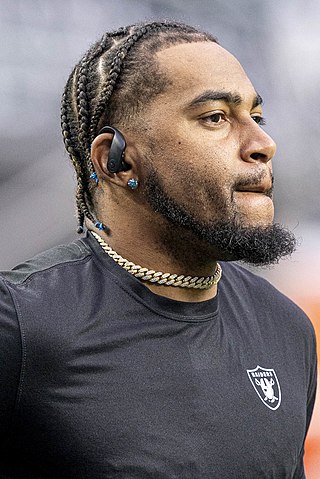
DeSean William Jackson is an American football wide receiver who is a free agent. He played college football for the California Golden Bears, where he was recognized as a consensus All-American in 2006 and 2007. He was drafted by the Philadelphia Eagles in the second round of the 2008 NFL Draft, and has also played for the Washington Redskins, Tampa Bay Buccaneers, and Los Angeles Rams. Jackson has been selected to the Pro Bowl three times, and was the first player selected to the Pro Bowl at two different positions in the same year when he was named to the 2010 Pro Bowl as a wide receiver and return specialist.
The 1950 Cleveland Browns season was the team's first in the National Football League (NFL) after playing the previous four years in the All-America Football Conference (AAFC), which folded after the 1949 season. The Browns finished the regular season with a 10–2 win–loss record and beat the Los Angeles Rams to win the NFL championship. It was Cleveland's fifth consecutive championship victory, the previous four having come in the AAFC.
The 1948 Chicago Cardinals season was the 29th season in franchise history. The Cardinals won the Western division on the final weekend at Wrigley Field over the cross-town Bears, and appeared in the NFL championship game for the second consecutive year. The defending champions lost 7–0 to the Eagles in a snowstorm in Philadelphia. It was their final postseason appearance as a Chicago team; they relocated southwest to St. Louis in 1960.
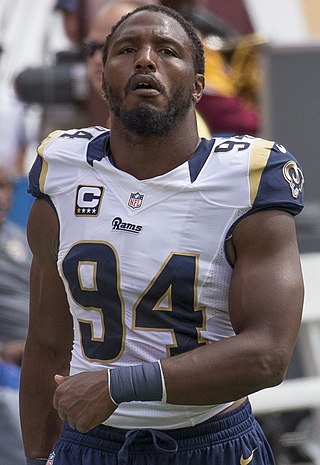
Robert Quinn is an American football defensive end who is a free agent. He played college football at North Carolina, and was drafted by the St. Louis Rams with the 14th pick in the first round of the 2011 NFL Draft.

Nicholas Edward Foles is an American football quarterback who is a free agent. He played college football at the University of Arizona and was selected in the third round of the 2012 NFL Draft by the Philadelphia Eagles. Foles had a breakout season in 2013 when he set the NFL season record for the best touchdown–interception ratio and led the Eagles to a division title, earning him Pro Bowl honors. Unable to duplicate his success the following year, Foles was traded to the St. Louis Rams, where he also struggled during his one season, and spent one season as a backup for the Kansas City Chiefs.
This is a list of playoff records set by various teams in various categories in the National Football League during the Super Bowl Era.
